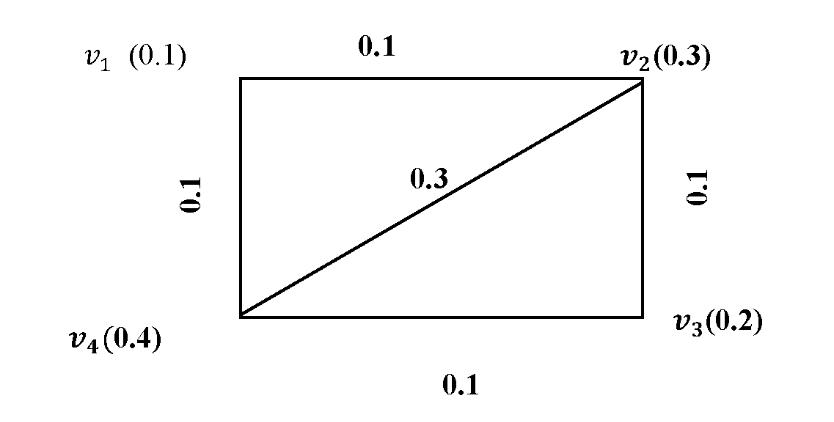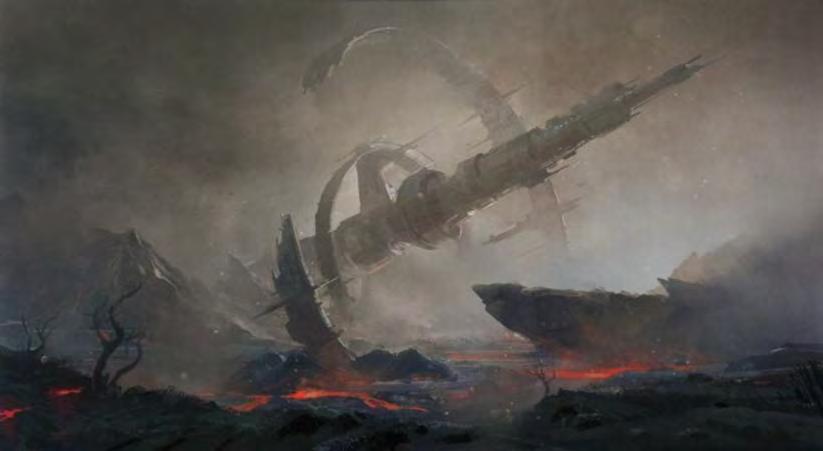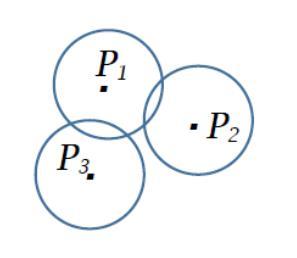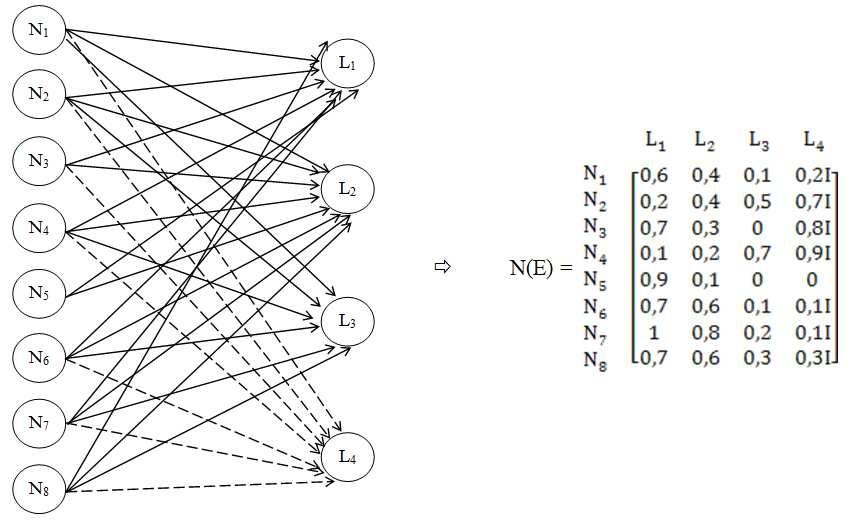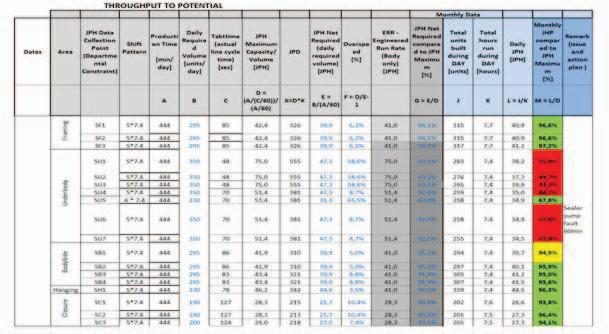
10 minute read
Minimum Spanning Tree in Trapezoidal Fuzzy Neutrosophic Environment
Advertisement
Said Broumi, Assia Bakali, Mohamed Talea, Florentin Smarandache, Vakkas Uluçay (2017). Minimum Spanning Tree in Trapezoidal Fuzzy Neutrosophic Environment. Advances in Intelligent Systems and Computing 735: 25–35; DOI: 10.1007/978-3-319-76354-5_3
Abstract. In this paper, an algorithm for searching the minimum spanning tree (MST) in a network having trapezoidal fuzzy neutrosophic edge weight is presented. The network is an undirected neutrosophic weighted connected graph (UNWCG). The proposed algorithm is based on matrix approach to design the MST of UNWCG. A numerical example is provided to check the validity of the proposed algorithm. Next, a comparison example is made with Mullai’s algorithm in neutrosophic graphs.
Keywords: Neutrosophic sets · Trapezoidal fuzzy neutrosophic sets Score function · Neutrosophic graph · Minimum spanning tree
1Introduction
In 1998, Smarandache [1] proposed the concept of neutrosophic set (NS) from the phil‐osophical point of view, to represent uncertain, imprecise, incomplete, inconsistent, and indeterminate information that are exist in the real world. The concept of neutrosophic set generalizes the concept of the classic set, fuzzy set, and intuitionistic fuzzy set (IFS). The major differences between the IFS and neutrosophic set (NS) are the structure of the membership functions, the dependence of the membership functions, and the constraints in the values of the membership functions. A NS has a triple-membership structure which consists of three components, namely the truth, falsity and indetermi‐nacy membership functions, as opposed to the IFS in which information is described by a membership and non-membership function only. Another major difference is the constraint between these membership functions. In a NS, the three membership func‐tions are independent of one another and the only constraint is that the sum of these membership functions must not exceed three. This is different from the IFS where the
values of the membership and non-membership functions are dependent on one another, and the sum of these must not exceed one. To apply the concept of neutrosophic sets (NS) in science and engineering applications, Smarandache [1] initiated the concept of single-valued neutrosophic set (SVNS). In a subsequent paper, Wang et al. [2], studied some properties related to SVNSs. We refer the readers to [3, 11, 13–15] for more information related to the extensions of NSs and the advances that have been made in the application of NSs and its extensions in various fields. The minimum spanning tree problem is one of well–known problems in combinatorial optimization. When the edge weights assigned to a graph are crisp numbers, the minimum spanning tree problem can be solved by some well-known algorithms such as Prim and Kruskal algorithm. By combining single valued neutrosophic sets theory [1, 2] with graph theory, references [6–9] introduced single valued neutrosophic graph theory (SVNGT for short). The SVNGT is generation of graph theory. In the literature some scholars have studied the minimum spanning tree problem in neutrosophic environment. In [4], Ye introduced a method for finding the minimum spanning tree of a single valued neutrosophic graph where the vertices are represented in the form of SVNS. Mandal and Basu [5] proposed an approach based on similarity measure for searching the optimum spanning tree prob‐lems in a neutrosophic environment considering the inconsistency, incompleteness and indeterminacy of the information. In their work, they applied the proposed approach to a network problem with multiple criteria. In another study, Mullai et al. [10] discussed about the minimum spanning tree problem in bipolar neutrosophic environment.
The main purpose of this paper is to propose a neutrosophic version of Kruskal algorithm based on the matrix approach for searching the cost minimum spanning tree in a network having trapezoidal fuzzy neutrosophic edge weight [12].
The rest of the paper is organized as follows. Section 2 briefly introduces the concepts of neutrosophic sets, single valued neutrosophic sets and the score function of trape‐zoidal neutrosophic number. Section 3 proposes a novel approach for searching the minimum spanning tree in a network having trapezoidal fuzzy neutrosophic edge length. In Sect. 4, a numerical example is presented to illustrate the proposed method. In Sect. 5, a comparative example with other method is provided. Finally, Sect. 6 presents the main conclusions.
2Preliminaries and Definitions
In this section, the concept of neutrosophic sets single valued neutrosophic sets and trapezoidal fuzzy neutrosophic sets are presented to deal with indeterminate data, which can be defined as follows.
Definition 2.1 [1]. Let � be an universal set. The neutrosophic set A on the universal set � categorized in to three membership functions called the true TA(x), indeterminate IA(x) and false FA(x) contained in real standard or non-standard subset of ]−0, 1+[ respec‐tively.
− 0 ≤ supTA(x) + supIA(x) + supFA(x) ≤ 3+ (1)
i.If s(A1) ≻ s(A2), then A1 is greater than A2, that is, A1 is superior to A2, denoted by
⌣ A1 ≻
⌣ A2
If s(A1) = s(A2), and H(A1) ≻ H(A2) then A1 is greater than A2, that is, A1 is superior
to A2, denoted by
A1 ≻
⌣ A2.
3Minimum Spannig Tree Algorithm of TrFN- Undirected Graph
In this section, a neutrosophic version of Kruskal’s algorithm is proposed to handle Minimum spanning tree in a neutrosophic environment and a trapezoidal fuzzy neutro‐sophic minimum spanning tree algorithm, whose steps are described below:
Algorithm:
Input: The weight matrix M = [W weighted neutrosophic graph (UWNG). ij]n×n for which is constructed for undirected
Step 1: Input trapezoidal fuzzy neutrosophic adjacency matrix A.
Step 2: Construct the TrFN-matrix into a score matrix [S tion (8). ij]n×n by using the score func‐
Step 3: Repeat step 4 and step 5 up to time that all nonzero elements are marked or in another saying all (n−1) entries matrix of S are either marked or set to zero.
Step 4: There are two ways to find out the weight matrix M that one is columns-wise and the other is row-wise in order to determine the unmarked minimum entries Sij, besides it determines the weight of the corresponding edge eij in M.
Step 5: Set Sij = 0 else mark Sij provided that corresponding edge eij of selected Sij generate a cycle with the preceding marked entries of the score matrix S.
Step 6: Construct the graph T including the only marked entries from the score matrix
S which shall be the desired minimum cost spanning tree of G.
Step 7: Stop.
4Numerical Example
In this section, a numerical example of TrFNMST is used to demonstrate of the proposed algorithm. Consider the following graph G = (V, E) shown Fig. 1, with fives nodes and fives edges. The various steps involved in the construction of the minimum cost spanning tree are described as follow:
According to the Figs. 3 and 4, the next non zero minimum entries 0.525 is marked and corresponding edges (4, 5) are also colored.
1
0.575
0.592
2
0.542
0.583
0.458
3
0.6
4
0.525
5
Fig. 3. An illustration of the marked edge
1
Fig. 4. Score matrix
0.575
2
0.583 0.542
0.592 0.458
3
0.6
4
0.525
5
Fig. 5. An illustration of the marked edge (4, 5)
According to the Fig. 6, the next minimum non zero element 0.542 is marked (Figs. 5 and 7).
According to the Fig. 10. The next minimum non zero element 0.583 is marked. But while drawing the edges it produces the cycle. So we delete and mark it as 0 instead of 0.583.
Fig. 10. Score matrix
The next non zero minimum entries 0.592 is marked it is shown in the Fig. 11. But while drawing the edges it produces the cycle. So we delete and mark it as 0 instead of 0.592.
Fig. 11. Score matrix
According to the Fig. 12. The next minimum non zero element 0.6 is marked. But while drawing the edges it produces the cycle so we delete and mark it as 0 instead of 0.6.
Fig. 12. Score matrix
After the above steps, the final path of minimum cost of spanning tree of G is portrayed in Fig. 13.
Based on the procedure of matrix approach applied to undirected neutrosophic graph. hence, the crisp minimum cost spanning tree is 2, 1 and the final path of minimum cost of spanning tree is {1, 2}, {2, 4}, {4, 3}, {4, 5}.
1
0.57
2
0.54
450.
4
0.52
5
3
Fig. 13. Final path of minimum cost of spanning tree of G.
5Comparative Example
To demonstrate the rationality and effectiveness of the proposed method, a comparative example with Mullai’s algorithm [10] is provided. Following the step of Mullai’s algo‐rithm.
Iteration 1: Let C1 = {1} and C1 = {2, 3, 4, 5} Iteration 2: Let C2 = {1, 2} and C2 = {3, 4, 5} Iteration 3: Let C3 = {1, 2, 4} and C3 = {3, 5} Iteration 4: Let C4 = {1, 2, 4, 3} and C4 = {5}
From the results of the iteration processes, the TrFN minimal spanning tree is:
2 4
1
5
3
Fig. 14. TrFN minimal spanning tree obtained by Mullai’s algorithm.
From the Fig. 14, it can be observed that the TrFN minimal spanning tree {1, 2}, {2, 4}, {4, 3}, {4, 5} obtained by Mullai’s algorithm, after deneutrosophication of edges’ weight, is the same as the path obtained by the proposed algorithm.
The difference between the proposed algorithm and Mullai’s algorithm is that Mullai’s algorithm is based on the comparison of edges in each iteration of the algorithm and this leads to high computation whereas the proposed approach based on Matrix approach can be easily implemented in Matlab.
6Conclusion
In this paper, a new approach for searching the minimum spanning tree in a network having trapezoidal fuzzy neutrosophic edge length is presented. The proposed algorithm use the score function of TrFN number, then a comparative example is worked out to illustrate the applicability of the proposed approach. In the next research paper, we can apply the proposed approach to the case of directed neutrosophic graphs and other kinds of neutrosophic graphs including bipolar neutrosophic graphs, and interval valued neutrosophic graphs.
References
1. Smarandache, F.: Neutrosophy. Neutrosophic probability, set, and logic. In:
ProQuest Information & Learning, Ann Arbor, Michigan, USA(1998) 2. Wang, H., Smarandache, F., Zhang,Y., Sunderraman, R.: Single valued neutrosophic sets. In: Multisspace and Multistructure, vol. 4, pp. 410–413 (2010) 3. Kandasamy, I.: Double-valued neutrosophic sets, their minimum spanning trees, and clustering algorithm. J. Intell. Syst. 1–17 (2016). https://doi.org/10.1515/ jisys-2016-0088 4. Ye, J.: Single valued neutrosophic minimum spanning tree and its clustering method. J.
Intell.Syst. 23, 311–324 (2014) 5. Mandal, K., Basu, K.: Improved similarity measure in neutrosophic environment and its application in findingminimum spanningtree.J. Intell. Fuzzy Syst. 31, 1721–1730 (2016) 6. Broumi, S., Bakali, A., Talea, M., Smarandache, F., Kishore Kumar, P.K.: Shortest path problem on single valued neutrosophic graphs. In: 2017 International Symposium on
Networks, Computers and Communications (ISNCC) (2017). (in press) 7. Broumi, S., Talea, M., Bakali, A., Smarandache, F.: Single valued neutrosophic graphs. J.
New TheoryN 10, 86–101(2016) 8. Broumi, S., Talea, M., Smarandache, F., Bakali, A.: Single valued neutrosophic graphs: degree, order and size. In: IEEE International Conference on Fuzzy Systems (FUZZ), pp. 2444–2451 (2016) 9. Broumi, S., Smarandache, F., Talea, M., Bakali, A.: Decision-making method based on the interval valuedneutrosophicgraph. In: FutureTechnologie, pp. 44–50. IEEE (2016) 10. Mullai, M., Broumi, S., Stephen, A.: Shortest path problem by minimal spanning tree algorithm using bipolarneutrosophic numbers. Int. J.Math. Trends Technol. 46(N2), 80–87 (2017) 11. http://fs.gallup.unm.edu/NSS/ 12. Ye, J.: Trapezoidal fuzzy neutrosophicset and its application to multiple attributedecision making. In: Neural Computing and Applications (2014). https:// doi.org/10.1007/s00521-014-1787-6
13. Zhang,C., Li, D., Sangaiah, A.K., Broumi, S.: Mergerand acquisition targetselection based oninterval neutrosophicmultigranulation rough sets over two universes. In: Symmetry, vol. 9, no. 7, p. 126 (2017). https://doi.org/10.3390/sym9070126 14. Abdel-Basset, M., Mohamed, M., Sangaiah, A.K.: Neutrosophic AHP-delphi group decisionmaking model basedon trapezoidalneutrosophicnumbers. J.Ambient Intell.Hum.
Comput.1–17 (2017). https://doi.org/10.1007/s12652-017-0548-7 15. Abdel-Basset, M., Mohamed, M., Hussien, A.N., Sangaiah, A.K.: A novel group decision-making model based on triangular neutrosophic numbers. Soft Comput. 1–15 (2017). https://doi.org/10.1007/s00500-017-2758-5


